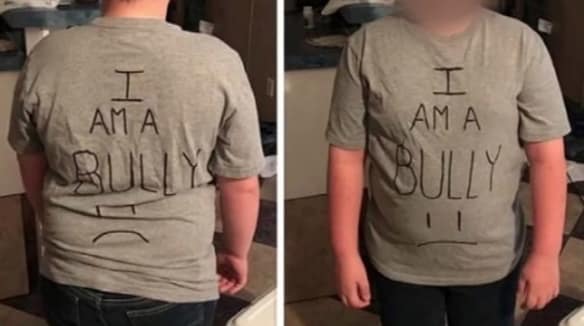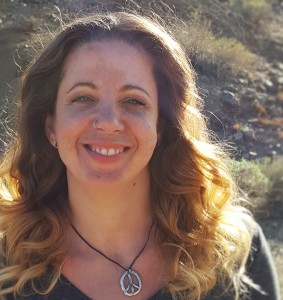via ABC News
bul·ly
ˈbo͝olēnoun
-a person who uses strength or power to harm or intimidate those who are weaker.
synonyms: persecutor, oppressor, tyrant, tormentor, intimidator;verb
-use superior strength or influence to intimidate (someone), typically to force him or her to do what one wants.
A few days ago, BuzzFeed ran an article about a mom’s “unique” parental move to punish her son. He’d been unkind to kids at school, so she made him wear a t-shirt that said, “I’m a bully”, both front and back.
(Unique, by the way, is in quotes because, Buzzfeed? This sort of public shaming is anything BUT unique. It’s – unfortunately – one of the most popular parenting trends out there, and one I’ve written about several times.)
Mom has, as expected, been widely praised for this decision, with few people failing to recognize its sad irony. The biggest problem with this type of parenting tactic (and make no mistake, there are plenty) is that it is teaching the child that it is okay to do the very thing you don’t want them to do! Read the definition of bully again. “A person who uses strength or power to harm or intimidate those who are weaker.” Or as a verb: “to use superior strength or influence to intimidate (someone), typically to force him or her to do what one wants.” This mom, by very definition, is bullying her son, for….. bullying. She is in essence telling him that it’s okay to use force, intimidation, and humiliation to make your point. She is telling him that it’s okay to negatively use your position of power and authority over someone to make them do what you want. She is telling him that it’s okay to throw a child’s mistakes in their face, chastise them for their bad decisions, and publicly shame them for their poor choice in judgment.
Is what the boy did wrong? Absolutely! But as the proverbial saying goes, two wrongs do not make a right. Mom’s bullying of the boy does not in any way absolve either one of them of their behavior.
I can’t pretend to know why this particular boy chose to bully. What I do know though, is that people have a tendency to act as well as they feel. There’s a reason why the expression, “Hurt people hurt people” is so often touted to explain poor behavior. Someone who is hurting, or feeling unloved, or unseen, or unappreciated, might lash out and hurt others. Someone who feels badly about themselves might look for flaws in others to make themselves feel better. Someone who feels weak might pick on someone who seems even weaker. Someone who’s bullied may very well turn around and bully others. People who are hurting inside hurt others. It is a sad truth, but it’s one that can’t be ignored.
And make no mistake, bullying should never, ever be excused. Unkindness of any sort should always be addressed, and discussed, and navigated together as parent and child. It’s a particularly … yucky (for lack of a better word) part of parenting, but it’s an important one nonetheless. In fact, just a few days ago, I had to help one of my children around a bullying situation – my child was on the receiving end – and I walked away with many feelings, one of which was gratitude at how it was handled by all parents involved.
Kids are still learning. Their brains are literally still forming. They’re human, and sometimes they mess up. Sometimes they mess up badly. And yes, sometimes they might be unkind. It’s not our job as parents to respond to unkindness with more unkindness! Our job is to set a boundary, yes, but to also offer unconditional love (which, in its absence, may be the very thing causing the bullying in the first place.) Our job is to show them how to treat others. Our job is to be the ultimate models of kindness to all people… starting with our own children.
And when your child IS the bully? It comes down to compassion, and understanding, and finding out the WHY. That “why” is so important! Behavior doesn’t exist in a vacuum. People aren’t unkind for no reason. If your child is a perpetrator, or for that matter a victim, of a bullying situation: look for the why, and then go from there. Responding to bullying with more bullying will only make the situation worse. Talk to your children, but even more importantly, listen. They’ll tell you what you need to know. Once you have a frame of reference, you can form a plan and move forward with a solution.
No shaming t-shirts necessary.

(Visited 2,631 times, 1 visits today)









Wow, yes, I feel like there is so much pressure to “do something, anything” about bullying, or school violence, or sexual assault, that our first societal response is always shaming children who are hurting others. “That’ll fix them.” As if shaming is somehow the brave thing to do, and anything else is coddling. I’m an unschooling mom, and I can say that shame and blame are the easiest things, in the sense that they are the first things that pop into my head when my kids are hurting/annoying/frustrating each other. I don’t want that to be my response, and I hope (?) I’m learning, but the parental toolbox I ended up with from experience has lots of shame and blame in it. When I do take the time to understand my kids, it is so worth it and they seem to get something out of it, as opposed to when I meet meanness with meanness. But it’s hard, and takes actual conscious thought.